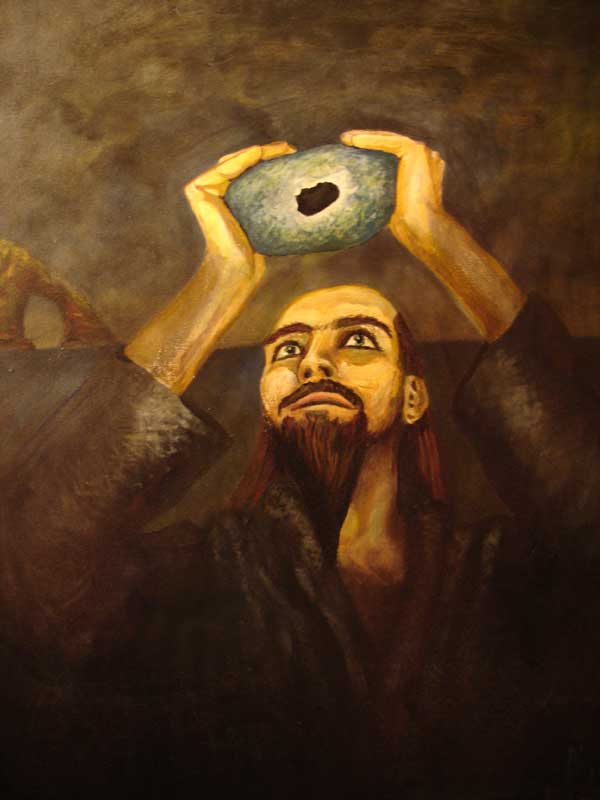Prophecy – Scottish Second Sight
The Scots are a superstitious people. We have a strong sense of the ‘otherworld’ of portents, fairy people and tempting of fate: Scottish grannies are particularly good at spinning yarns of mysterious goings-on. One belief which has remained strong throughout the ages is that of Second Sight: the ability to see into the future and predict events ahead of time. The history of the Highlands is littered with prophets, or seers as they’re known; and very often their words foretold doom and disaster for one clan or another.
Easily the best known and most popular of Highland prophets is Kenneth Mackenzie, The Brahan Seer; who may (or may not) have lived around 400 years ago to the north and west of Inverness. The story goes that his mother cut a deal with the spirit of a Danish princess, and in return for letting the wraith return to her grave the power of second sight would be gifted upon her child. In the morning Kenneth awoke to find a stone with a hole cut through the middle next to his bed. On looking through the stone he was engulfed with visions, good and bad, of a future yet to come. In time he would learn to control this gift and make numerous predictions for his own people and for the Highlands as a whole.
Although he is most famous for predicting the downfall of his own clan, the Mackenzies of Seaforth, with a dramatic vision of deaf chiefs, white-hooded lassies and tragedy; he also foresaw the destinies of many other clans as well, for example – “When the big-thumbed sheriff officer and the blind man of the twenty-four fingers shall meet, then MacNeil of Barra shall prepare for a flitting“. It is known that this prophecy came true in 1838 when the last of the MacNeils of Barra left Kisimul Castle behind bankrupt (a ‘flitting’ in Scotland is to move house). Most of his predictions follow this vein, with many being very specific. Many of the prophecies are about battles or hardship ahead, and often a little macabre: “The day will come when the raven will drink its three fills of the blood of Clan Donald on top of the Hills of Minaraidh in Lewis“; ravens drinking the blood is a recurring theme. He would also foresee the changes that ravaged the Highlands during the Clearances of the 18th and 19th century that began in Ross-shire.
“The day will come when there will be a road through the hills of Ross-shire from sea to sea, and a bridge on every stream. Then the people of the land will degenerate and grow weak as their country improves . . . and the clansmen will flee from their native country before an army of sheep” Anyone who knows something of the history of the Highlands will know just how much that sadly came to pass, with sheep replacing men, and whole glens emptied of their people by a brutal aristocracy and their agents. Still, the seer goes on in another vision: “the people will emigrate to islands now unknown in the boundless oceans, after which the deer and other wild animals shall be exterminated by horrid Black Rains. The people will then return and take undisturbed possession of the lands of their ancestors.” This is a reference to the mass emigration from Scotland in the 19th century; but we still await the horrid black rain, and this is one of the most feared predictions in the Highlands still to be fulfilled.
The Brahan Seer wasn’t the only prophet to foretell the Clearances, and considering the social and personal upheavals it caused it’s no wonder. In the 1640s on the shores of Loch Tay in Highland Perthshire lived a seer known as the ‘Lady of Lawers’. It is likely she was Mary Campbell who married John Stewart of Appin, and lived at the big house in the now deserted village of Lawers. She too saw the coming of the sheep and the evicting of the people: “The land will first be sifted and then riddled of its people, and the jaw of the sheep will drive the plough from the ground. The homes on Loch Tay shall become so scarce that a cock crowing will not be heard from one to the other.” Today, the once heavily cultivated slopes of Loch Tay are now almost exclusively put over to sheep grazing.
The landlord was the Marquess of Breadalbane, who’s estate in the 19th century was nearly half a million acres; and he was instrumental in evicting at least 3000 people from Lochtayside during the worst excesses of the Clearances. Not that his family would be spared from the foresight of the Lady of Lawers either: “The day will come when the Campbells of Breadalbane will have a thousand rents, then one rent, then no rents at all; what was put together in hides shall be rent asunder in laces. The last laird will pass over Glenogle with a grey pony leaving nothing behind.” In the 1920s the estate fell into a sharp decline with mounting debts and by the 30s it was bust. Countess Breadalbane sold the last of the estate in 1948 and left the area in a trap pulled by a grey pony.

Breadalbane – Hard hit by the Clearances
Sometimes landowners made the mistake of evicting seers as well, and one such soothsayer forcibly removed from Jura in the early 1700s left her Campbell landlord with an ominous prediction: “The last Campbell laird of Jura will be blind in one eye, and will leave the island with all of his belongings tied to a cart pulled by a lone white horse.” This was well known to the islanders, and finally came true in 1938 when Charles Campbell, who’d been blinded in the First World War fell on hard times, sold up and left the island behind with nothing but a cart and horse. Today, the Isle of Jura distillery produces a whisky commemorating the story, called “Prophecy”
Not all prophecies are doom and gloom; some have a more positive aspect. For example it is well known to the Clan Cameron that “As long as there’s snow on Ben Nevis the Camerons will command Locheil“. At 4409ft, Ben Nevis is the highest mountain in the British isles and looms high and large over the Cameron estates of Locheil; being so high the snow has only melted six times in the last 120 years, only to remain the next year. The Camerons I think are safe. But, eventually we may all be doomed by the famous words of the Border prophet known as ‘Thomas the Rhymer’: “When the Cows of Gowrie come to land, the Judgement Day is near at hand.” The Cows of Gowrie are two boulders sitting in the sands of the Firth of Tay near Dundee, and it is said they move landward at about an inch a year.
The legend goes that Thomas the Rhymer, who lived in the 13th century in the village of Earlston near Melrose, was enchanted by a fairy queen dwelling deep within the Eildon Hills. He was allowed to return to the mortal world for a short time, and was granted the gift of second sight; before eventually spending eternity in the world of the fairies. The story is similar in theme to the ‘gifting’ of the power to the Brahan Seer; and the sidhe, or fairy people play a large part in old superstitions and legends in Scotland. It may be a folk-memory of an older, lost culture that had certain shamanic ritual, and thus lots of prophecies. Many people across the globe, through their own natural shrewdness and perhaps with the help of hallucinogens have been venerated in their culture as being able to divine the future. The seers are our version of this, and many people have claimed the gift, or curse, right down to the present day – it may well have its origins in our very ancient past. It certainly makes for great storytelling.
This article was written by David McNicoll, who runs Vacation Scotland – a travel company specialising in tours and vacation packages to Scotland. For more info – www.vacationscotland.biz
Tagged












Here’s something weird – the word used by Australian Gaels to mean “television” is “taidhsearachd”, which originally meant “second sight”. (The word used in Scotland is “telebhisean”).
I am Scottish on both sides of my family. My parents were Donald Bruce and Madeline Mackinnon. My mother’s father had second site and predicted events..